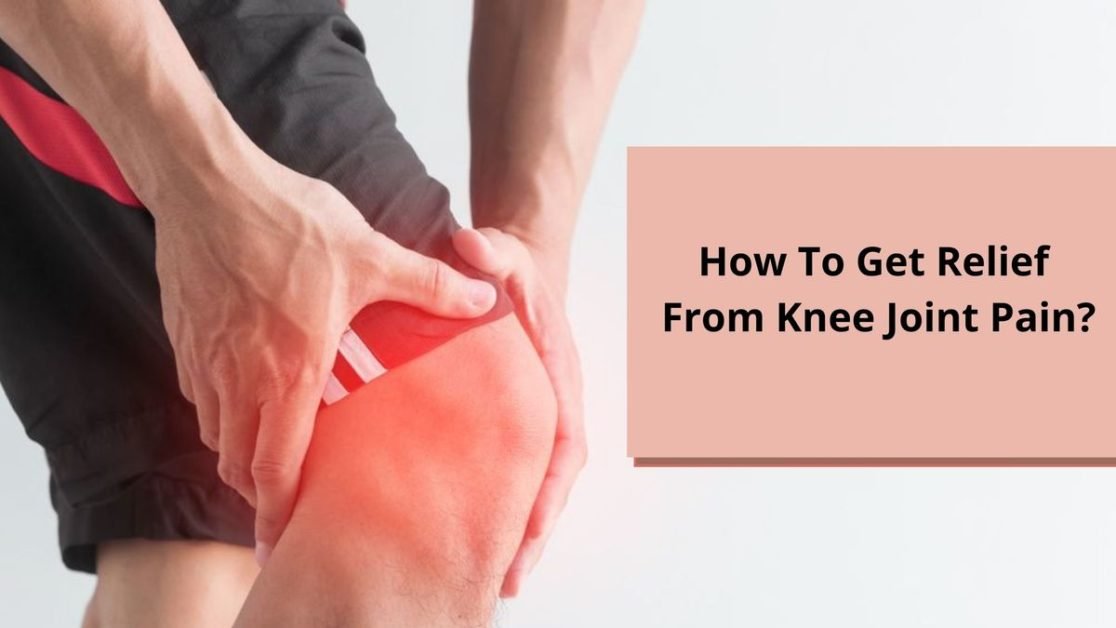How To Get Relief From Knee Joint Pain? Causes And Useful Remedies

Knee pain is a common condition that affects and occurs in all ages. It can occur suddenly or develop over time, and it may be acute (lasting no more than six weeks) or chronic (longer than six weeks).
Causes And Useful Remedies For Knee Joint Pain

The knee joint is a hinge joint that allows movement in several directions. The knee joins the thigh bone (femur) to the lower leg bone (tibia). The kneecap (patella) lies above and behind the joint to help form it.
Knee pain can come on suddenly or gradually, and it’s usually not serious — you can manage it at home. But if your knee pain lasts more than a few days, you should see your doctor.
Common Causes Of Knee And Joint Pain
If you’re experiencing knee or joint pain, it could be due to any number of conditions. While the cause of your pain will be investigated by your doctor, some common causes include:

Osteoarthritis (OA)
Arthritis refers to inflammation of a joint and can occur as a result of injury, overuse, or degeneration due to aging. It occurs when cartilage in the joints wears away, causing bones to rub together and become inflamed. The majority of people with OA have osteophytes (bumpy bone growths) on the edges of their bones where they meet at the joints.

Patellofemoral Pain Syndrome (Runner’s Knee)
This condition occurs when your kneecap doesn’t track properly over the knee joint, causing friction and pain on the underside of your kneecap. Patellofemoral pain syndrome is most common among young and middle-aged adults who participate in sports that require repetitive knee bending such as running or cycling. However, it can occur in anyone who engages in these activities.

Meniscus
Tissue discs act as shock absorbers between the femur and tibia, preventing damage to these bones from repeated stress and pressure from their movement around each other during walking or running. They also help to stabilize the joint. The medial meniscus is on the inner side of the knee, while the lateral meniscus is on its outer side.

Sprains and strains
These injuries can be caused by twisting or stretching ligaments around your knee joint. You may feel a “pop” or hear a crack when the ligament tears. If you suffer from a sprain or strain, you may be able to walk on it immediately, but it’ll hurt if you put weight on it.

Poor posture
If you sit at a desk all day long without taking frequent breaks to stretch out and move around, you can develop tight muscles in and around your pelvis, lower back, hips, and knees that cause stiffness and discomfort when you stand up or walk around. This condition is sometimes referred to as sedentary osteoarthritis because it tends to occur more often in people who don’t move much during the day than in those who do regular exercise (such as walking).
Underlying Causes Of Joint Pain And Knee Pain
The following are some of the underlying causes of joint pain and knee pain

Gout
Gout is another common cause of joint pain and knee pain. It occurs when uric acid crystals in the joints build up causing inflammation and swelling. The condition usually affects men over 40 years old who have high levels of uric acid in their blood

Overuse
If you tend to use your knees continuously without giving them time to rest, you may develop osteoarthritis in them. This type of arthritis is caused by continuous pressure on the cartilage that cushions the bones inside your joints.

Bursitis (It is an inflammation or irritation of a bursa)
A small sac that reduces friction between tendons, muscles, and bones. The most common locations for bursitis include the shoulder (subacromial bursa) and hip (trochanteric bursa).

Joint Instability
A joint that’s unstable doesn’t have a stable range of motion, meaning it doesn’t move smoothly when you bend or straighten your leg. This can cause pain when you’re walking or running.

Rheumatoid Arthritis (RA)
Rheumatoid arthritis (RA) is an autoimmune disease that causes inflammation in joints throughout the body. RA usually affects small joints first — like those in your hands and feet — before moving on to larger ones like your knees. The inflammation caused by RA can make it difficult for you to move around comfortably without pain or stiffness affecting your ability to work or play sports.
How To Treat The Condition?
The first step in treating knee pain is to see your doctor. Your doctor may order tests such as x-rays or MRI scans to help determine what’s causing your pain. If surgery is needed, your doctor can perform it with minimally invasive techniques that reduce recovery time and increase mobility.
1. Exercises
Joints need to be exercised as much as muscles. You can strengthen your knees by doing exercises like squats, lunges, and step-ups. These exercises will involve both your quads (front of thigh) and hamstrings (back of thigh), as well as your glutes (buttocks).
2. Massage
Massaging the area around your knees can help reduce pain. Use a tennis ball or golf ball to massage the back of your thighs and calves. Be sure not to press too hard — just enough pressure so you feel it! If that still doesn’t work, consider hiring a professional therapist for some deep tissue massage therapy.
3. Ice packs Or Heat Packs
You can use ice packs or heat packs to treat joint pain and knee pain. Use ice packs if your pain is moderate to severe, while heat packs are suitable for milder cases. You can apply either one to your affected knee immediately after exercise or physical activity.
4. Medication
If your knee pain persists despite icing and heating, ask your doctor about taking nonsteroidal anti-inflammatory drugs (NSAIDs). These medications include ibuprofen (Advil) and naproxen sodium (Aleve). They reduce inflammation and swelling in the joints.
5. Eat a balanced diet
If your diet lacks essential nutrients, your body may not produce enough cartilage to repair itself properly after injury or surgery. Foods rich in vitamin C and E — such as citrus fruits and green leafy vegetables — are especially good for your joints because they help keep them strong and healthy.
Are There Any Related Health Conditions?
There are several medical conditions that can cause knee pain. These include:
👉Osteoarthritis. This is the most common reason for osteoarthritis and is caused by a breakdown of cartilage in the joints, leading to pain and swelling. It can affect people of all ages but is more common in older adults.
👉Rheumatoid arthritis. This is an autoimmune disease that causes inflammation and damage to the lining of the joints (synovium). It mainly affects women over the age of 50 and is more common in African-American women than white women.
👉Chronic obstructive pulmonary disease (COPD). This is a group of lung diseases that includes emphysema and chronic bronchitis. COPD causes airflow obstruction which makes it hard to breathe deeply or cough out mucus from your lungs. As you age, you’re more likely to develop COPD if you smoke or have asthma or other lung diseases.
Is There Any Natural Remedy?
Natural remedies for knee pain include taking supplements that support the joints and muscles, getting enough sleep, eating a healthy diet, and exercising regularly. These may also help:
👉Ginger. Ginger contains compounds called gingerols and shogaols that may reduce inflammation. Ginger can be taken as a capsule or as tea.
👉Turmeric. Turmeric is another spice with anti-inflammatory properties. It’s available in supplement form or as a tea made from ground turmeric root (you can find it at most grocery stores).
👉Boswellia serrata extract. This extract from Indian frankincense gum has been shown to have anti-inflammatory effects in animal studies. It’s available in supplement form or as a tea made from ground Boswellia serrata resin (you can find it at some health food stores).
👉Chondroitin sulfate and glucosamine sulfate. These substances are found naturally in cartilage and are often used by people with osteoarthritis to help treat joint pain and stiffness caused by the condition. They’re available over-the-counter as pills or liquids to take by mouth, or as injections into painful joints that don’t respond well to other treatments.
How Can You Get Rid Of Inflammation Around Your Knee And Joint?
Inflammation is a normal response to tissue damage, but when it becomes chronic, it can cause pain and other problems. Inflammation around the knee can be caused by trauma, arthritis, or other medical conditions.
To help reduce inflammation in the joint
👉Rest your leg. Use ice for 15 minutes at a time every two to three hours. Apply an elastic bandage after icing to help reduce swelling.
👉Take anti-inflammatory medications such as ibuprofen or naproxen. If you have kidney disease or are on blood thinners, consult your doctor before taking these drugs.
👉Use heat therapy instead of ice if you’ve had an injury within the last 48 hours or if you’re experiencing significant swelling around your knee joint area. The heat helps relax stiff muscles and improve circulation while reducing swelling.
👉Talk with your doctor about physical therapy exercises that will strengthen muscles around your knee joint area while also stretching them out to relieve tension in the surrounding tissues.
👉Wear shoes that fit well and provide some support for your feet and ankles as well as proper arch support for your arches (or “bones”).
Does Physiotherapy Help?
Physiotherapy is a great way to manage joint and knee pain.
The physiotherapist will assess your condition, talk to you about the best treatment options for you and create a plan for you to follow.
It may be that you need to do some exercises at home and return for another appointment.
Or it may be that you have one or more sessions of physiotherapy treatment where exercises are done in the clinic with supervision from your physiotherapist.
Final Words
When it comes to knee joint pain, you have a few treatment options. First, you can try conservative treatments like rest, ice, and over-the-counter painkillers—these are inexpensive and highly effective for many people. Still, this post isn’t about these popular treatments: It’s about more aggressive remedies that might just get you heading in the right direction. That said, relief from the discomfort is within reach; you just need to know where to look for it.
Dr. Edward Zelman
Dr. Edward Zelman is a distinguished and highly respected medical professional who has dedicated his career to the field of general medicine. With a profound commitment to patient care and a wealth of knowledge acquired over decades of practice, Dr. Zelman has earned a reputation as a trusted healthcare provider in his community. With a career defined by excellence and an unwavering commitment to the betterment of his patients and the broader community, Dr. Edward Zelman stands as a pillar of the medical field, dedicated to the principles of healing and compassionate care. At present, Dr. Edward Zelman is researching safe and effective natural remedies that can restore as well as maintain the youthful functioning of the body.
View All By Dr. Edward






